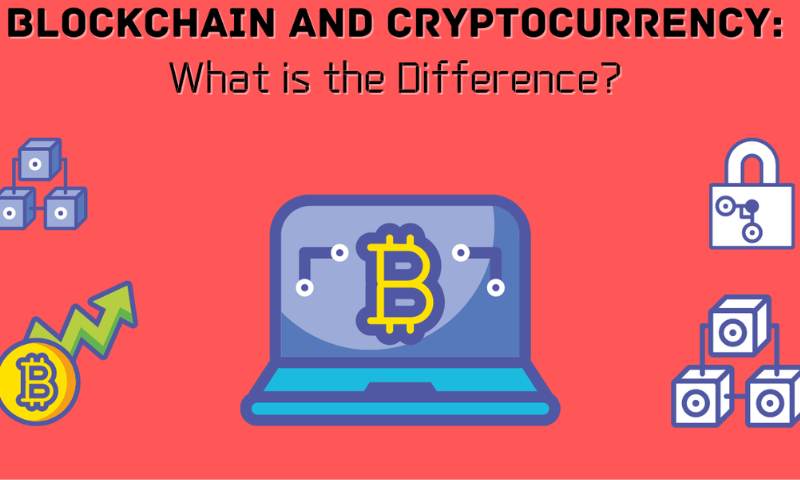Decoding the Difference between Cryptocurrency and Blockchain can feel like hacking through a digital jungle. Yet, you’re here to gain clear-cut insights, and that’s what I deliver. The terms often get tangled up, but grab your mental machete because we are about to carve out the key distinctions. Cryptocurrency is digital money, plain and simple – it’s secure, and sends fast without needing banks. Blockchain, though, is a tech whiz, a genius record-keeper that’s not just for money moves. Prepare to dive into their foundations and look under the hood at how they tick, because understanding their unique traits is key to unlocking the future of digital transactions.
Understanding the Foundations of Cryptocurrency and Blockchain
The Basic Principles of Digital Currencies
Digital currencies are like online money. They live on the internet. You can use them to buy things or as an investment, just like regular money. But they’re special because they don’t have actual coins or paper notes. Instead, they use technology to move around in a secure way. Most times, when people talk about digital money, they mean cryptocurrency.
Cryptocurrency is a kind of digital currency that’s super private and safe. It keeps your money secure with something called encryption. This is like secret code that protects your money from hackers. You can send cryptocurrency to anyone in the world, and no banks are needed. This is called peer-to-peer.
People keep their cryptocurrency in a digital wallet. To buy or send cryptocurrency, you need to use a special key. Think of this like a super-secret password. Each transaction gets a clear record online. This shows who owns what without sharing personal info.
Core Blockchain Fundamentals
Now, let’s talk about blockchain. This is the smarty-pants tech behind Bitcoin and other cryptocurrencies. It’s like a super security guard for your data. Blockchain keeps a list of all transactions ever made. It’s like a digital ledger that everyone can see, but no one can mess up.
You know when you and a friend keep track of what you owe each other by writing on a piece of paper? Imagine if that piece of paper lived on thousands of computers at once. That’s blockchain. It’s a bunch of records, called blocks, that are linked together in a chain. Every block has info that checks it’s legit.
The cool part is, blockchain isn’t just for keeping track of money. You can use it for other things like making contracts without needing a lawyer or keeping health records safe.
This tech is so neat because it’s decentralized. No single person or company controls it. Instead, a big network of computers is in charge. They all follow rules to agree on any new changes. This is called consensus. If a computer tries to make any funny business, the others won’t agree, and the change won’t happen. This makes blockchain super trusty for all sorts of stuff.
So, cryptocurrency is the money, and blockchain is the super tech that keeps it safe. They’re like best friends who need each other. Without blockchain, cryptocurrency couldn’t stay secure. And without cryptocurrency, blockchain would be like a safe with nothing inside. Both have big jobs for keeping stuff online safe and sound.
In a nutshell, while cryptocurrency works like invisible safe money, blockchain is the whiz tech that makes sure everything checks out. And the best part? Blockchain can do a whole lot more than just money stuff – it’s a whole new way to keep info safe, share it, and make sure it’s real.
The Technology Behind Cryptocurrency and Its Unique Characteristics
Decoding How Cryptocurrencies Function
Cryptocurrencies work like magic internet money. But how do they work? Someone shouts, “What is cryptocurrency vs blockchain technology?” Cryptocurrency is digital money powered by blockchain. “Understanding blockchain” is like learning how a magic trick works. The “digital currencies explained” is simple – they use math and computers to make safe payments.
“Technology behind Bitcoin” and “crypto coins overview” is fascinating. Imagine a treasure chest (that’s the blockchain), where everyone can see the chest but only you can open your small box inside with a special key (that’s your “cryptographic protocols”). This chest is super safe, and no one can mess with what’s inside your box once it’s locked.
“Blockchain networks” are like neighborhoods of treasure chests. “Decentralized ledger technology” means no one boss owns the chests. It’s all people agreeing on who owns what. “Blockchain without cryptocurrency” happens too. Like making a list of who borrowed your toys without using money. Just tracking who has what.
When someone asks, “What are the types of cryptocurrency?” You can think of Bitcoin as the first collector card. Now, there are lots of different digital coins, like trading cards, each with a special thing about them.
“Smart contracts role” is like a pinky promise made with magic. If you do your part of the deal, the magic does the other part automatically. No need for a grown-up to make sure. The “blockchain data structure” keeps all the pinky promises safe.
Now, “Technology behind Bitcoin” is a trail of breadcrumbs. “Bitcoin transaction process” means every time you pass Bitcoin to someone, a breadcrumb drops. Those crumbs make a trail that can never be lost. Cool, huh?
Some people worry about “blockchain scalability issues.” Like, what if everyone brought a toy to track in our chests? Would it still work? That’s what some smart people are trying to figure out how to handle more without making a mess.
“Public vs private blockchain” is like your toy chest at home versus at school. At home, only family can see it (private). At school, all friends can see (public). But at school, there’s a list of rules on who can play with what (that’s “blockchain governance”).
People use blockchain for all sorts of things now, not just for money. Like keeping score in games or making sure no one cheats (“blockchain innovation beyond crypto”). “Investing in digital currencies” is like betting on which trading card will become super popular.
To wrap it up, the “cryptocurrency value proposition” is like having a unique collector card. It might be worth a lot to someone. “How blockchain works” is all about keeping those collector’s items safe and making sure no one can claim your card without your key.
Always remember, kiddos, “blockchain” is the magic chest, and “cryptocurrency” is the treasure inside. Keep asking questions, stay curious, and you’ll soon be a tech wizard too!
Exploring the Mechanics and Applications of Blockchain
Blockchain Data Structure and Transaction Process
Let’s dive right into how blockchain works. Think of it like a digital book that keeps records. Each page in this book is a “block,” carrying info about transactions. Once a page fills up, it gets added to the previous pages, forming a “chain.”
Imagine sending a coin to a friend. Your transaction is grouped with others. It’s locked in a block and linked to the chain. This chain is visible to everyone, making it super clear. It uses complex math, but don’t sweat it. It’s about keeping your stuff safe.
With blockchain, no single person can control all the data. It’s like a game where everyone’s moves are out there. So, no cheating. Smart people called “miners” use powerful computers to check each move. Once a block is done, miners get a reward, often new digital coins. This is mining.
Blockchain’s Role in Various Industries Beyond Currency
Now, let’s look beyond money. Blockchain isn’t just for coins. It’s a big deal in lots of areas. Take healthcare, for example. Here, blockchain can safely store patient records that only special keys can open.
In the supply chain, companies track goods from start to finish. They can see where their stuff goes and if it’s all good quality. This means no fake goods and a happy customer.
Real Estate is another area. Imagine buying a house with fewer papers and quicker steps. That’s blockchain making things slick. And for voting, blockchain can make sure every vote counts right and that everything’s fair.
So you see, there’s more to blockchain than just cryptocurrency. It’s a tech with many tricks up its sleeve. It can show who owns a digital painting or help a farmer prove his food is organic. It’s all about trust and proof, without needing a middleman.
Whether it’s a coin, a contract, or a medical record, blockchain keeps it tight and right. This trusty tool is changing all sorts of games, way beyond just trading cash. It’s got the muscle to back up its hustle, making sure everyone plays by the rules.
Delving into the Similarities and Variances: Tokens, Coins, Ledgers, and Networks
Token Versus Coin: Understanding Types of Cryptocurrency
Let’s talk money, but not the old school kind. In the world of digital cash, words like tokens and coins mean a lot. They’re both types of cryptocurrency, sure, but they’re not twins. Think of tokens as the versatile kind of money. They can represent a bunch of different things. A token might stand for a slice of a company, or give you a right to use a service.
Coins, on the other hand, are the digital version of the coins jingling in your pocket. They’re made to be money and nothing else. Bitcoin is the big name you’ve probably heard. It leads the pack and sticks to being money. When you hear “cryptocurrency,” you’re likely thinking of coins like Bitcoin.
So, when we talk crypto coins, we’re keeping it simple – just money for buying and trading. But when we bring up tokens, we’re stepping into a world where crypto gets creative and does more than just pay for stuff.
Public vs Private Blockchain Networks and Their Use Cases
Now flip the page to blockchain networks, the tech magic behind Bitcoin and pals. They’re like the scorekeepers of who owns what in the crypto game. But not all scorekeepers are the same. We’ve got public and private ones, and they’ve got different jobs.
Public blockchains are the big, open-to-all diaries where every transaction is out there for anyone to see. Think of them as a huge, shared spreadsheet. Anyone can join in and keep an eye on the action. Bitcoin plays on this team, with its wide-open, see-through setup.
Private blockchains? They’re the hushed, VIP areas of the blockchain world. You need a special pass to get in. Companies like these because they can keep their secrets while still getting blockchain’s benefits.
In short, public blockchains are all about lots of eyes keeping things honest. But private blockchains are more about control and privacy. Both have their shining moments depending on what the job calls for.
So there you have it. Tokens can be money plus all sorts of other cool stuff. Coins are just money, pure and simple. Public networks are for everyone to see, and private ones are for eyes with VIP passes. And all of this sits on blockchain technology, a super-smart way to keep track of transactions that’s changing the game in money and beyond. It’s a brave new world, and we’re all unlocking its secrets, one block at a time.
In this post, we dug into the tech that’s changing money: cryptocurrency and blockchain. We started with the basics of digital cash and how blockchains work. Next up, we talked about how crypto coins like Bitcoin function and what makes them special. We also explored how blockchains help with more than just money, reaching into different fields.
Remember, tokens and coins are not the same, and blockchains can be public or private, each with unique uses. To sum it up, this world of digital cash and chains of data blocks is rich and full of promise, with a lot of depth to explore. It’s a blend of tech, trust, and a touch of finance magic. Keep learning and stay curious – there’s always more to uncover in the crypto universe!
Q&A :
What is the fundamental distinction between cryptocurrency and blockchain?
Blockchain is the underlying technology that enables the existence of cryptocurrency. It is a decentralized digital ledger that records transactions across many computers in such a way that the recorded transactions cannot be altered retroactively. Cryptocurrency, on the other hand, is a digital or virtual form of currency that uses cryptography for security and operates on a blockchain platform. It is the digital asset or token that people can buy, sell, or exchange.
How does blockchain technology work independent of cryptocurrency?
Blockchain technology is not limited to just supporting cryptocurrencies; it has a wide array of applications beyond them. It can be used for smart contracts, supply chain management, voting systems, and more. The technology provides a secure and transparent way to record transactions and manage data across a network of computers without the need for a centralized authority or intermediary.
Can a blockchain exist without cryptocurrencies?
Yes, a blockchain can certainly exist without cryptocurrencies. Cryptocurrency is just one use case of blockchain technology. Blockchains can be used to create a secure and immutable record of any type of transaction or data across various industries. Examples include tracking the provenance of goods in a supply chain, managing medical records, or recording property ownership.
Are all cryptocurrencies based on blockchain technology?
While the majority of cryptocurrencies operate on blockchain technology due to its security and decentralization benefits, not all digital currencies use it. There are other technologies like Directed Acyclic Graph (DAG) that some digital currencies use instead. Nevertheless, blockchain remains the most popular and widely implemented underlying technology for cryptocurrencies.
Does investing in blockchain mean investing in cryptocurrencies?
Investing in blockchain does not necessarily mean investing in cryptocurrencies. While buying cryptocurrencies involves investing directly in digital assets on a blockchain, investing in blockchain can also mean investing in companies that develop or use blockchain technology for various applications. This can include investing in blockchain startups, technology firms, or funds focused on the broader blockchain ecosystem.


